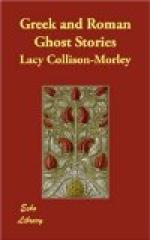The Larvae had distinct attributes, and were thought to cause epilepsy or madness. They were generally treated more or less as a joke,[17] and are spoken of much as we speak of a bogey. They appear to have been entrusted with the torturing of the dead, as we see from the saying, “Only the Larvae war with the dead."[18] In Seneca’s Apocolocyntosis,[19] when the question of the deification of the late Emperor Claudius is laid before a meeting of the gods, Father Janus gives it as his opinion that no more mortals should be treated in this way, and that “anyone who, contrary to this decree, shall hereafter be made, addressed, or painted as a god, should be delivered over to the Larvae” and flogged at the next games.
Larva also means a skeleton, and Trimalchio, following the Egyptian custom, has one brought in and placed on the table during his famous feast. It is, as one would expect, of silver, and the millionaire freedman points the usual moral—“Let us eat, drink, and be merry, for to-morrow we die."[20]
The Larvae were regular characters in the Atellane farces at Rome, where they performed various “danses macabres.” Can these possibly be the prototypes of the Dances of Death so popular in the Middle Ages? We find something very similar on the well-known silver cups discovered at Bosco Reale, though Death itself does not seem to have been represented in this way. Some of the designs in the medieval series would certainly have appealed to the average bourgeois Roman of the Trimalchio type—e.g., “Les Trois Vifs et les Trois Morts,” the three men riding gaily out hunting and meeting their own skeletons. Such crude contrasts are just what one would expect to find at Pompeii.
Lemures and Larvae are often confused, but Lemures is the regular word for the dead not at rest—the “Lemuri,” or spirits of the churchyard, of some parts of modern Italy. They were evil spirits, propitiated in early days with blood. Hence the first gladiatorial games were given in connection with funerals. Both in Greece and in Rome there were special festivals for appeasing these restless spirits. Originally they were of a public character, for murder was common in primitive times, and such spirits would be numerous, as is proved by the festival lasting three days.
In Athens the Nemesia were held during Anthesterion (February-March). As in Rome, the days were unlucky. Temples were closed and business was suspended, for the dead were abroad. In the morning the doors were smeared with pitch, and those in the house chewed whitethorn to keep off the evil spirits. On the last day of the festival offerings were made to Hermes, and the dead were formally bidden to depart.[21]
Ovid describes the Lemuria or Lemuralia.[22] They took place in May, which was consequently regarded as an unlucky month for marriages, and is still so regarded almost as universally in England to-day as it was in Rome during the principate of Augustus. The name of the festival Ovid derives from Remus, as the ghost of his murdered brother was said to have appeared to Romulus in his sleep and to have demanded burial. Hence the institution of the Lemuria.




